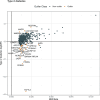Sequence variants associated with BMI affect disease risk through BMI itself
- PMID: 39532837
- PMCID: PMC11557886
- DOI: 10.1038/s41467-024-53568-9
Sequence variants associated with BMI affect disease risk through BMI itself
Abstract
Mendelian Randomization studies indicate that BMI contributes to various diseases, but it's unclear if this is entirely mediated by BMI itself. This study examines whether disease risk from BMI-associated sequence variants is mediated through BMI or other mechanisms, using data from Iceland and the UK Biobank. The associations of BMI genetic risk score with diseases like fatty liver disease, knee replacement, and glucose intolerance were fully attenuated when conditioned on BMI, and largely for type 2 diabetes, heart failure, myocardial infarction, atrial fibrillation, and hip replacement. Similar attenuation was observed for chronic kidney disease and stroke, though results varied. Findings were consistent across sexes, except for myocardial infarction. Residual effects may result from temporal BMI changes, pleiotropy, measurement error, non-linear relationships, non-collapsibility, or confounding. The attenuation extent of BMI genetic risk score on disease associations suggests the potential impact of reducing BMI on disease risk.
© 2024. The Author(s).
Conflict of interest statement
Figures




References
-
- Franks, P. W. & Atabaki‐Pasdar, N. Causal inference in obesity research. J. Intern. Med.281, 222–232 (2017). - PubMed
-
- Mokdad, A. H. et al. Prevalence of obesity, diabetes, and obesity-related health risk factors, 2001. JAMA289, 76–79 (2003). - PubMed
-
- Bastien, M., Poirier, P., Lemieux, I. & Després, J.-P. Overview of epidemiology and contribution of obesity to cardiovascular disease. Prog. Cardiovasc. Dis.56, 369–381 (2014). - PubMed
-
- Van Gaal, L. F., Mertens, I. L. & De Block, C. E. Mechanisms linking obesity with cardiovascular disease. Nature444, 875–880 (2006). - PubMed
MeSH terms
LinkOut - more resources
Full Text Sources

